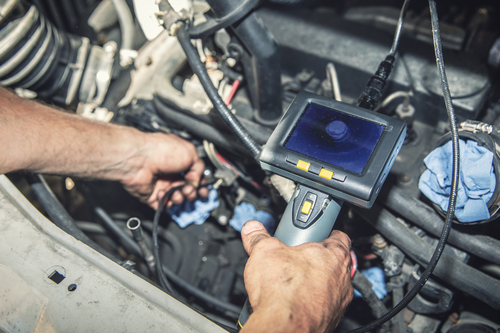When you work on cars, accuracy is very important. It can save you time and money to be able to quickly and correctly find problems, whether you’re fixing an engine or doing regular maintenance. The borescope is one of the tools that has changed the way engine checks are done. Professionals in the car industry can now locate and accurately diagnose engine problems thanks to these flexible inspection cameras. In particular, the Piston Borescope Inspection Camera has become an important tool for mechanics and techs because it lets them look at parts of an engine that they couldn’t see before without taking it apart.
What Is a Borescope?
A borescope is an inspection tool used to look at places that are hard to see or can’t be reached with the naked eye. It’s made up of a long, bendable tube with a camera on the end that can be put into small engine openings like spark plug holes, exhaust ports, or other tight spots. Live video from the camera is sent to a monitor, which lets techs check out parts inside the engine without taking it apart. This saves time and money because it keeps people from having to do work that isn’t necessary.
How Borescopes Enhance Diagnostics
Engine diagnostics have traditionally required a lot of guesswork and sometimes involved dismantling parts of the engine to determine the source of an issue. This process is not only time-consuming but can also result in the need for expensive repairs if the problem is incorrectly diagnosed. Borescopes, however, allow automotive technicians to directly observe the internal condition of an engine and its components.
The Piston Borescope Inspection Camera is specifically designed for inspecting the pistons, cylinder walls, and other internal engine parts. A technician can look at the state of the piston rings, cylinder walls, and valves by putting the camera into the cylinder through the hole for the spark plug. This is crucial when diagnosing issues like low compression, misfires, or oil burning, as these problems can often be caused by internal engine wear that is difficult to detect without direct inspection.
With the help of a borescope, technicians can identify problems such as scoring, cracks, carbon buildup, and excessive wear. So, they can figure out the exact cause of the problem without having to guess. The result is a more accurate diagnosis, faster repair times, and less chance of overlooking underlying problems that could lead to future engine failure.
Improving Repair Accuracy
Once an issue has been accurately diagnosed using a borescope, repairs can be carried out more precisely. For example, if the borescope reveals a worn piston or cylinder wall, the technician can make a more informed decision about whether a simple repair, such as replacing the piston rings, is sufficient, or if a more comprehensive rebuild is required.
In the past, when technicians couldn’t directly see internal engine components, they might have opted for a more generalized approach, potentially resulting in unnecessary repairs or missing the true cause of the problem. The borescope provides a clearer picture of the situation, which helps ensure that repairs are focused on the root cause of the issue.
Furthermore, the use of borescopes can help in post-repair inspections to verify that the repair has been completed successfully. For example, after an engine rebuild, a technician can use a borescope to inspect the cylinder walls and pistons to confirm that everything is in proper working order. This keeps the owner of the car from having to pay for expensive repairs and makes sure they get the best service possible.
Saving Time and Reducing Costs
The most obvious benefit of using a borescope in automotive diagnostics and repair is the significant time and cost savings it provides. By eliminating the need to disassemble engine parts to inspect internal components, technicians can complete jobs much more quickly. This also translates to reduced labor costs for the customer. The ability to immediately pinpoint the problem means that the necessary repairs can be made with greater accuracy, avoiding the trial-and-error approach that might be employed without the use of a borescope.
Conclusion
Incorporating a Piston Borescope Inspection Camera into automotive diagnostics has transformed how technicians diagnose and repair car engines. The ability to visually inspect internal components without disassembly allows for more accurate diagnostics, faster repair times, and a reduction in unnecessary repairs. By improving both the precision of engine inspections and the speed of repairs, borescopes are not only benefiting automotive professionals but also their customers, who can enjoy a higher level of service and more affordable repairs.
